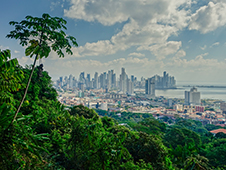
The majority of Key Biodiversity Areas (KBAs) contain infrastructure. Currently, at least 37% of KBAs identified for birds contain urban areas, while at least 76% contain roads, resulting in increased accessibility, which facilitates further urban development, illegal hunting, logging and spread of invasive species. Urban areas are also associated with high levels of light pollution, which can negatively impact migratory species in particular. More than 80% of all KBAs are at least partly covered by light-polluted night skies, while more than two-thirds lie entirely under artificially bright skies.

The development of residential and commercial areas is a major threat to global biodiversity. Impacts to birds occur mainly through habitat loss and fragmentation, but also through pollution, disturbance and collisions with structures. Expansion of residential and commercial areas is almost always associated with development of related infrastructure, such as roads, railways and energy infrastructure, compounding the threats to nature. Urban areas are expanding rapidly. One recent study estimated that the total global urban extent will increase up to five-fold during 2000-2100, with the fastest rates of expansion in Africa and Asia (Gao & O’Neill 2020). If poorly planned, this development could have extensive negative impacts on biodiversity.
At least 37% of KBAs identified for birds contain urban areas, including almost half of those in Europe, 40% in the Middle East and 38% in Central America (Simkins et al. in review). Most KBAs identified for birds (at least 76%) also contain roads, resulting in increased accessibility, which facilitates further urban development and other threats such as illegal hunting, logging and spread of invasive species (Simkins et al. in review). Urban areas are also associated with high levels of light pollution, which can negatively impact migratory species in particular. More than 80% of all KBAs are at least partly covered by light-polluted night skies, while more than two-thirds lie entirely under artificially bright skies (Garrett et al. 2019). Mirroring the pattern of urban areas, the regions with the greatest proportion of KBAs lying completely under polluted skies are Europe (94%) and the Middle East (88%).
References
Garrett, J. K., Donald, P. F. & Gaston, K. J. (2019) Skyglow extends into the world’s Key Biodiversity Areas. Anim. Conserv. 23(2): 153-159
Gao, J. & O’Neill, B. C. (2020) Mapping global urban land for the 21st century with data-driven simulations and Shared Socioeconomic Pathways. Nat. Commun. 11: 2302
Simkins, A. et al. (In review) A global assessment of the prevalence of current and future infrastructure in Key Biodiversity Areas
Compiled: 2022 Last updated: 2022
Recommended Citation:
BirdLife International (2022)
Infrastructure development is a threat to the most important areas for biodiversity.
Downloaded from https://datazone.birdlife.org/sowb/casestudy/infrastructure-development-is-a-threat-to-the-most-important-areas-for-biodiversity on 23/12/2024